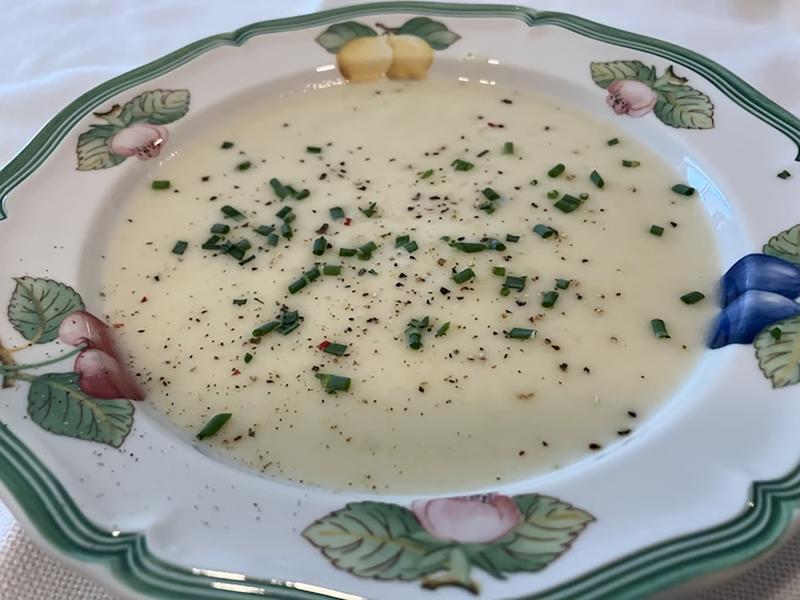Leeks fill special niche in culinary world
This week, I’d like to introduce you to one of my favorite vegetables - leeks. Although a member of the lily family and cousin to the onion, leeks fill a special niche in the culinary world for their unique flavor. They resemble green onions, with a white base and green leaves, however, they are far thicker and tighter with wider stalks. They’re typically harvested throughout the late summer and into fall, so you’ll be seeing them in your grocery store and farmers markets.
Leeks carry the Latin name is Allium porrum and originated in Central Asia. They have been enjoyed for centuries, found on the menu (and in tomb paintings) of the ancient Egyptians. Roman gastronomer, Apicus wrote extensively about how to cook leeks, especially as a featured food at sumptuous feasts. According to legend, Saint David, patron saint of Wales instructed his soldiers to wear leeks in their caps during battle with the Saxons in the sixth century.
However, the vegetable that became the symbol of Wales, worn at rugby matches and on Saint David’s Day, may have a longer history. In Shakespeare’s Henry V, the king states that his is wearing a leek because he is Welch. Household accounts from the time of the Tudors show payments for leeks worn by the household guards on St. David’s Day and 14th Century Welch archers adopted green and white colors of the leek for their uniforms.
Poet Michael Drayton first recounted the story of the warriors being asked to wear leeks by Saint David, but some scholars and food historians surmise it was the earlier traditions of the Druid priests and doctors who taught the leeks’ value as a cure for illness and source of pain relief. It may also be the high nutritional density, as leeks are rich in minerals (iron, potassium, phosphorus, magnesium, copper, and calcium) as well as B vitamins and fiber.
In the Middle Ages, leek cultivation was introduced to Europe, where it has remained a highly prized vegetable to this day. Leeks arrived in North America with the arrival of the first settlers. Both as a vegetable and as a condiment, leeks have constantly enhanced a wide variety of dishes with their subtle fragrance and mild, sweet taste. When selecting leeks, look for taut whites and dark, unblemished greens that are firm and not browned.
The white base of the leek remains underground and collects soil between the leaves as they grow making them notoriously gritty. To wash, cut off the root, leaving the pad attached. Start at the top and slice in half down the entire length of the leek. Gently spread apart the leaves under running water to rinse away any of the trapped dirt. Discard any of the outermost leaves if they are not pristine.
One of the most familiar dishes made with leeks is called vichyssoise, a creamy potato and leek soup that is usually served chilled. According to my neighbor, Inge, who gave me a copy of Julia Child’s recipe, one should never try to substitute onions for the leeks. This may seem like a simple recipe: boil leeks and potatoes in broth, then purée the mixture and stir in cream. But, the tool you select for making the purée is critical.
The potato ricer is your best choice, breaking down the potato into a smooth and fluffy mash while only rupturing the cells once as they pass through the perforated base. This ensures they won't get overworked and gummy as they would with an immersion blender or food mill. Finally, be sure to season well with salt, since cold temperatures will mask flavors, and scatter the soup with freshly snipped chives. Of course, you can always enjoy your soup while wearing a leek in your cap!
Vichyssoise*
3 C peeled, sliced potatoes
3 C sliced leeks
5 C chicken stock
2/3 C heavy cream
salt, to taste
snipped chives, for garnish
Combine potatoes, leeks, and broth in a soup pot; bring to a boil. Reduce heat and simmer until completely tender, about 45 minutes. Pass the mixture through a potato ricer into a saucepan. Stir in cream and salt generously. Chill for at least one hour. Serve garnished with snipped chives. Yield: 6 to 8 servings. *Adapted from Julia Child.
Roasted Leeks
6 leeks
3 T olive oil
1/2 t salt
1/4 t white pepper
1/4 C grated Parmesan cheese
Preheat oven to 425 F. Trim off the root portion and dark green tops of the leeks. Cut them in half lengthwise and rinse well to remove any trapped dirt. Arrange in a single layer, cut side down in a 9 by 13-inch baking dish. Drizzle with olive oil and toss to coat completely. Roast for 20 minutes, then turn over leeks to cut-sides up. Sprinkle with cheese and roast until golden, about 10 minutes. Yield: 6 servings.
Sautéed Leeks
2 large leeks
2 T unsalted butter
salt, to taste
Trim and discard the root end and any browned green tops of the leeks. Cut in half lengthwise; slice crosswise into one-inch pieces. Place the leeks in a bowl and cover with water, swishing to dislodge any dirt that will settle in the bottom. Melt 1 T butter in a large skillet over medium. Lift the leeks from the water with a slotted spoon, shaking off any excess water. Add leeks to the pan and sprinkle with salt. Cover and reduce heat to medium low. Cook for about 30 minutes, stirring often. Remove from heat and add remaining 1 T butter; stir to combine. Adjust seasonings to taste with salt. Yield: 4 servings.





















































